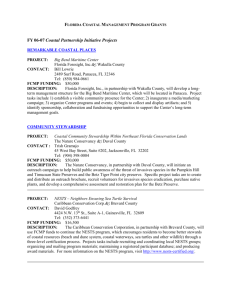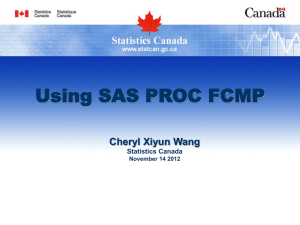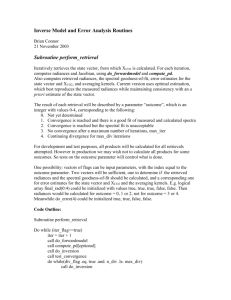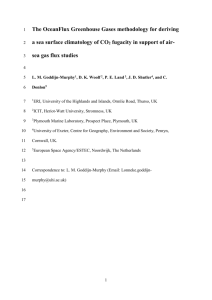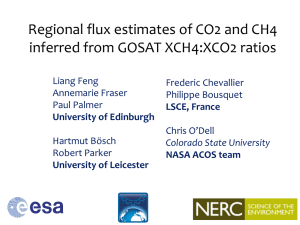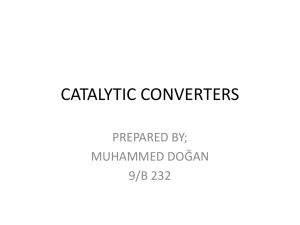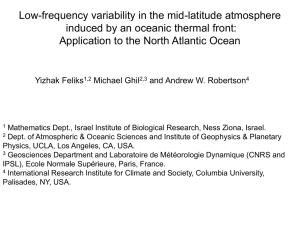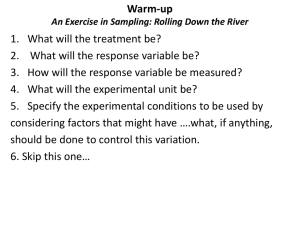Recalculating the carbon dioxide data
advertisement
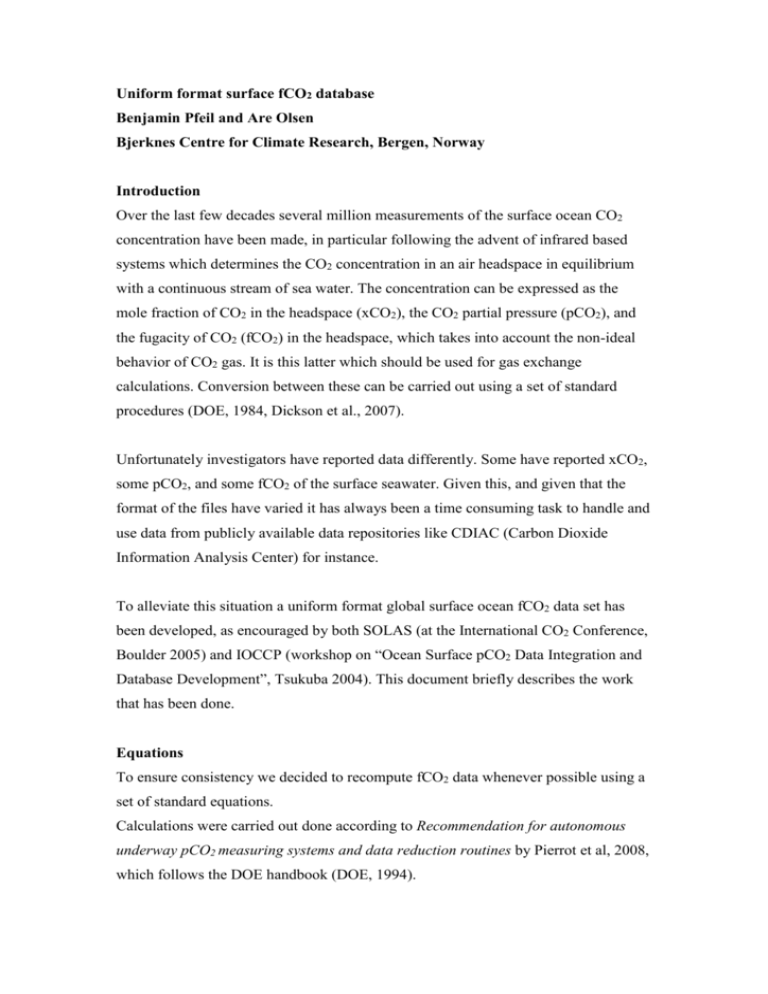
Uniform format surface fCO2 database Benjamin Pfeil and Are Olsen Bjerknes Centre for Climate Research, Bergen, Norway Introduction Over the last few decades several million measurements of the surface ocean CO2 concentration have been made, in particular following the advent of infrared based systems which determines the CO2 concentration in an air headspace in equilibrium with a continuous stream of sea water. The concentration can be expressed as the mole fraction of CO2 in the headspace (xCO2), the CO2 partial pressure (pCO2), and the fugacity of CO2 (fCO2) in the headspace, which takes into account the non-ideal behavior of CO2 gas. It is this latter which should be used for gas exchange calculations. Conversion between these can be carried out using a set of standard procedures (DOE, 1984, Dickson et al., 2007). Unfortunately investigators have reported data differently. Some have reported xCO2, some pCO2, and some fCO2 of the surface seawater. Given this, and given that the format of the files have varied it has always been a time consuming task to handle and use data from publicly available data repositories like CDIAC (Carbon Dioxide Information Analysis Center) for instance. To alleviate this situation a uniform format global surface ocean fCO2 data set has been developed, as encouraged by both SOLAS (at the International CO2 Conference, Boulder 2005) and IOCCP (workshop on “Ocean Surface pCO2 Data Integration and Database Development”, Tsukuba 2004). This document briefly describes the work that has been done. Equations To ensure consistency we decided to recompute fCO2 data whenever possible using a set of standard equations. Calculations were carried out done according to Recommendation for autonomous underway pCO2 measuring systems and data reduction routines by Pierrot et al, 2008, which follows the DOE handbook (DOE, 1994). Unless otherwise specified, reported xCO2 data were assumed to be dry mole fractions standardized by each investigator with respect to calibration gas runs. Calculation of CO2 partial pressures from these data follows: dry ( pCO2 )wet equT (xCO2 ) equT (Pequ pH 2O) (1) where (xCO2 ) dry equT is the CO2 mole fraction and pH2Ois the water vapor pressure at equilibrator temperature. Water vapor pressure is calculated according to Weiss and Price (1980): pH 2O exp(24.4543 67.4509(100 T) 4.8489ln T 100 0.000544S (2) The correction for difference in intake and equilibrator temperatures was carried out using the emperical relationship derived by Takahahsi et al (1993) wet ( pCO2 ) wet SST (CO2 ) equT exp0.0423SST equT (3) where SST is the sea surface temperature in the same units as equT. If only fCO2 at equilibrator temperature was provided, the conversion to in situ temperature was carried out on this. Although several approaches are available (Copin- Montegut, 1988; Goyet et al., 1993; Takahashi et al., 1993; Weiss et al., 1982), the one of Takahashi et al. (1993) was preferred as it does not require knowledge of the alkalinity and TCO2 of the waters and was determined for isochemical conditions, while the others were not. The conversion of pCO2 to fCO2 values is carried out according to: ( fCO2 ) wet SST wet 2 CO2 ,SST Pequ B CO ,SST 2 1 x 2 CO 2 equT ( pCO2 ) wet SST exp R SST (4) where and Pequ is the and pressure (atm) of the equilibrator, and SST is the sea surface temperature (K). R = 82.0578 cm3 atm mol-1 K-1, and B(CO2,T) and (CO2,T) are the virial coefficients for CO2 (Weiss, 1974). B(CO2,T) in cm3 mol-1 is given by: BCO2,T 1636.75 12.0408 T 3.27957102 T 2 3.16528105 T 3 and (CO2,T) in cm3 mol-1 by: CO2,T 57.7 0188 T (5) (6) Implementation The sea surface CO2 concentration data in the files were reported in 11 different ways, and the large majority of the files contained data expressed in at least two different manners (e.g. xCO2 and fCO2). Ideally we would like to have always computed or recomputed fCO2 values from dry mole fractions along with reported equilibrator and intake temperatures, equilibrator pressure, and surface salinity using the set of equations given above. However, on many occasions not all of the required data were reported in the data files, and this necessitated the use of different starting points for our calculations and/or the use of data from external sources. In particular, atmospheric pressure and/or salinity data were sometimes missing. When pressure was missing we used 6 hourly sea level pressure data from the NCEP/NCAR reanalysis project (Kalnay et al., 1996). When salinity was not reported we used climatological monthly mean salinity data from the World Ocean Atlas 2005 (Antonov et al., 2005). All in all this means that fCO2 has been recomputed from different starting points and with different ancillary parameters. The different recomputed fCO2 parameters are given in Table 1. Most times it was possible to recompute fCO2 from different starting points in the same file, and we therefore provide the fCO2 recommended value in each file (fCO2_rec). This is the recomputed fCO2 value we recommend is used. If two or more recomputed fCO2 parameters is present, we recommend that the one calculated from closest to dry xCO2 values is used, and this is fCO2_rec in the data file. The order of preference is given in Table 1 as well. That is, if (1) was possible this was used as fCO2_rec, if (1) was not possible but (2) was, then (2) was used. If neither (1) nor (2) was possible but (3) was then this was used and so on. The philosophy behind this scheme was to (a) start out as close to dry xCO2 values as possible and (b) to limit use of external data to those cases were absolutely required (i.e. when no in situ fCO2 data could be obtained without resorting to WOA salinities or NCEP/NCAR pressures.). This also means for instance, that if fCO2 data were provided, but no xCO2 or pCO2, like from for instance a CARIOCA bouy, the fCO2 values were retained and are the fCO2_rec data in the file. Finally, if either atmospheric pressure or NCEP/NCAR were used, 3 hPa were added to account for the overpressure normally maintained in ships (Takahashi and Sutherland, 2007) Table 1: reported used for the recalculations in order of preference Indexb CO2 parameter Number required of cases extra var. 1 fCO2_insitu_from_xCO2_water_eq 2250925 ui_temp_dry_ppm 2 fCO2_insitu_from_xCO2_water_sst 204951 _dry_ppm 3 fCO2_from_pCO2_water_water_eq 724892 ui_temp 4 fCO2_from_pCO2_water_sst_100hu 334085 midity_uatm 5 fCO2_insitu_from_fCO2_water_equ 155969 i_uatm 6 fCO2_insitu_from_fCO2_water_sst 1978648 _100humidty_uatm 7 fCO2_from_pCO2_water_water_eq 26606 Pressure ui_temp_ncep 8 fCO2_from_pCO2_water_sst_100hu 1263959 Pressure midity_uatm_ncep 9 fCO2_insitu_from_xCO2_water_eq 2281 Salinity ui_temp_dry_ppm_woa 10 fCO2_insitu_from_xCO2_water_sst 2876 Salinity _dry_ppm_woa 11 fCO2_insitu_from_xCO2_water_eq 164 Pressure ui_temp_dry_ppm_ncep 12 13 14 fCO2_insitu_from_xCO2_water_sst _dry_ppm_ncep fCO2_insitu_from_xCO2_water_eq ui_temp_dry_ppm_ncep_woa fCO2_insitu_from_xCO2_water_sst _dry_ppm_ncep_woa 5860 Pressure 776 Pressure, Salinity Pressure, Salinity b Number is also used within the data file for identifying which reported CO2 variable is used as the recommended one (fCO2_rec). Reported data All scripts and in- and output data have been made available along with this report. Transparency is essential for assuring the best quality data product and we encourage all to evaluate our calculations to identify errors, which may occur. The data file contains all of the reported data, the NCEP/NCAR pressures and the WOA salinities. In addition bottom depth from ETOPO2 (http://www.ngdc.noaa.gov/mgg/global/global.html) has been included for identification of shelf and coastal data. The file also contains an identifier which shows what input parameter was used. It should also be evident whether the original data were provided at equilibrator or intake temperature. The following parameters are reported in the output file: Abbreviation Description unit cruise Cruise name (the file name) sta internal station number mon month day day yr year hh hour mm minute long longitude (0-360) deg lat latitude (-90-90) deg bottomD bottom depth as reported in file (can be deleted) m depth intake depth used if no intake depth was reported m depthW water intake depth as reported m temp sea surface temperature deg C sal sea surface salinity PSU XCO2_water_sst_ xCO2 water at sea surface temperature in wet air ppm xCO2 water at equilibrator temperature in wet air ppm xCO2 water at sea surface temperature in dry air ppm xCO2 water at equilibrator temperature in dry air ppm fCO2_water_sst_1 fCO2 water at sea surface temperature in wet air µatm 00humidity_uatm (100 % humidity) fCO2_water_corr2 fCO2 water corrected to 25 deg C sea surface 5_uatm temperature in wet air fCO2_water_corr_ fCO2 water corrected to 20 deg C sea surface to_20 temperature in wet air fCO2_water_equi_ fCO2 water at equilibrator temperature in wet air µatm pCO2_water_sst_1 pCO2 water at sea surface temperature in wet air µatm 00humidity_atm (100 % humidity) pCO2_water_equi pCO2 water at equilibrator temperature in wet air µatm pCO2_theta_SW_c pCO2 water at sea surface temperature in wet air µatm wet_ppm XCO2_water_equi _temp_wet_ppm XCO2_water_sst_ dry_ppm XCO2_water_equi _temp_dry_ppm µatm µatm atm _temp orrected_to_sst Temperature_equi temperature at equilibration deg C Pressure_atm atmospheric pressure as reported hPa Pressure_equi pressure in the equilibrator as reported hPa wind_direc_deg wind direction as reported deg wind_speed wind speed as reported m/s ship_speed ship speed knot ship_direc ship heading direction deg Humidity humidity % woa_sss salinity extracted from WOA 2005 PSU woa_land_marker 0 sea 1 land ncep_slp atmospheric pressure extracted from NCEP/NCAR hPa 6 hourly data speed_calc_knots Ship speed calculated knot ETOPO2 Bottom depth extracted from ETOPO2 m fCO2_insitu_from _xCO2_water_equ i_temp_dry_ppm fCO2 recomputed from xCO2 water at equilibrator µatm temperature in dry air; salinity and either atmospheric pressure or pressure at equilibration provided in the file fCO2_insitu_from _xCO2_water_sst_ dry_ppm fCO2 recomputed from xCO2 water at sea surface µatm temperature in dry air; salinity and either atmospheric pressure or pressure at equilibration provided in the file fCO2_from_pCO2 _water_water_equi _temp fCO2 recomputed from pCO2 water at equilibrator µatm temperature in wet air; salinity and either atmospheric pressure or pressure at equilibration provided in the file fCO2_from_pCO2 _water_sst_100hu midity_uatm fCO2 recomputed from pCO2 water at sea surface µatm temperature in wet air (100 % humidity); salinity and either atmospheric pressure or pressure at equilibration provided in the file fCO2_insitu_from _fCO2_water_equi _uatm fCO2 recomputed from fCO2 water at equilibrator µatm temperature in wet air; salinity and either atmospheric pressure or pressure at equilibration provided in the file fCO2_insitu_from _fCO2_water_sst_ 100humidty_uatm fCO2 recomputed from fCO2 water at sea surface temperature in wet air (100 % humidity); salinity and either atmospheric pressure or pressure at equilibration provided in the file µatm fCO2_from_pCO2 _water_water_equi _temp_ncep fCO2_from_pCO2 _water_sst_100hu midity_uatm_ncep fCO2 recomputed from pCO2 water at equilibrator µatm temperature in wet air, NCEP pressure used fCO2 recomputed from pCO2 water at sea surface µatm temperature in wet air (100 % humidity), NCEP pressure used fCO2_insitu_from _xCO2_water_equ i_temp_dry_ppm_ woa fCO2_insitu_from _xCO2_water_sst_ dry_ppm_woa fCO2_insitu_from _xCO2_water_equ i_temp_dry_ppm_ ncep fCO2_insitu_from _xCO2_water_sst_ dry_ppm_ncep fCO2_insitu_from _xCO2_water_equ i_temp_dry_ppm_ ncep_woa fCO2 recomputed from xCO2 water at equilibrator µatm temperature in dry air, salinity from WOA used fCO2 recomputed from xCO2 water at sea surface µatm temperature in dry air, salinity from WOA used fCO2 recomputed from xCO2 water at equilibrator µatm temperature in dry air, NCEP pressure used fCO2 recomputed from xCO2 water at sea surface temperature in dry air, NCEP pressure used µatm fCO2 recomputed from xCO2 water at equilibrator µatm temperature in dry air, NCEP pressure and salinity from WOA used fCO2_insitu_from fCO2 recomputed from xCO2 water at sea surface _xCO2_water_sst_ temperature in dry air, NCEP pressure and salinity dry_ppm_ncep_wo a from WOA used µatm fCO2_rec recoomended fCO2 µatm fCO2_source Identifies which reported CO2 value was used for calculations (see Table 1 for details) References Antonov, J.I., Locarnini, R.A., Boyer, T.P., Mishonov, A.V., Garcia, H.E., 2006. World Ocean Atlas 2005, Volume 2: Salinity. Levitus, S., ed, NOAA Atlas NESDIS 62, U.S. Government Printing Office, Washington, D.C., 182 pp. Copin-Montegut, C., 1988. A new formula for the effect of temperature on the partial pressure of CO2 in seawater. Marine Chemistry 25 (1), 29-37. DOE, 1994. Handbook of methods for the analysis of the various parameters of the carbon dioxide system in sea water. Version 2, Dickson, A.G., Goyet, C., eds, ORNL/CDIAC-74. Dickson, A.G., Sabine, C.L., Christian, J.R, 2007. Guide to best practices for ocean CO2 measurements. PICES Special Publication 3,191pp. Goyet, C., Millero, F.J., Poisson, A., Shafer, D.K., 1993. Temperature dependence of CO2 fugacity in seawater. Marine Chemistry 44 (2-4), 205-219. Kalnay, E. et al, 1996. The NCEP/NCAR 40-year reanalysis project. Bulletin of American Meteorological Society 77, 437-470. Pierrot, D., Neill, C., Sullivan, K., Castle, R., Wanninkhof, R., Lüger, H., Johannessen, T., Olsen, A., Feely R.A., Cosca, C.E., 2008. Recommendations for Autonomous Underway pCO2 Measuring Systems and Data Reduction Routines. Deep-Sea Research Part II. To be published. Takahashi, T., Olafsson, J., Goddard, J.G., Chipman, D.W., Sutherland, S.C., 1993. Seasonal-Variation of CO2 and Nutrients in the High-Latitude Surface Oceans – a Comparative-Study. Global Biogeochemical Cycles 7 (4), 843-878. Weiss, R.F., 1974. Carbon dioxide in water and seawater: the solubility of a non-ideal gas. Marine Chemistry 2, 203-215. Weiss, R.F., Jahnke, R.A., Keeling, C.D., 1982. Seasonal effects of temperature and salinity on the partial pressure of CO2 in seawater ( Pacific Ocean). Nature 300 (5892), 511-513. Weiss, R.F., Price, B.A., 1980. Nitrous oxide solubility in water and seawater. Marine Chemistry 8, 347–359.
